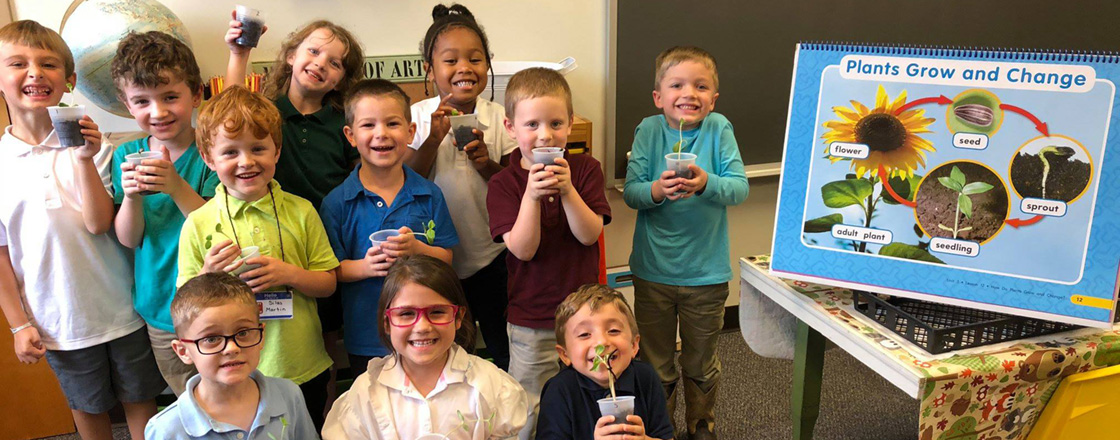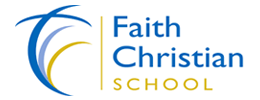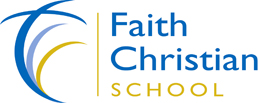
Option I
Full Day, five day-a-week sessions from 8:05 a.m. to 2:15 p.m.
• Full curricular morning program
• Lunch
• Afternoon enrichment including:
• Specialty classes in art, music, and physical education
• Curriculum extensions
• Relaxation/rest time
Option II
Half day, five-day-a-week sessions from 8:05 to 11:30 a.m.
• Full curricular program
• Thematic units
At Faith Christian School elementary students are encouraged to do their best and to participate. Student’s efforts, study habits, and personal development of values–such as responsibility, respect, cooperation and honesty–are as important as subject content. Watching students discover new things and teaching them to love learning are qualities in which we pride ourselves.
Kindergarten Academics
BIBLE — Learning about God/Bible memory
READING — 1 and 2 vowel words, intro to phonics, listening skills and sequencing, spelling
MATH — Count by 1’s, 5’s and 10’s and recognize numbers up to 100, time, money, shapes and colors, addition and subtraction to 10.
SOCIAL STUDIES — Holidays, occupations, home, school, pilgrims, Native Americans
HEALTH and SAFETY — hygiene, eating habits, teeth, school safety, stranger awareness
MUSIC, ART and PHYSICAL EDUCATION
“FULL DAY” KINDERGARTEN PREREQUISITES
The child should be able to do the following:
1. Keep balance – walk on a straight line without losing balance, being able to go up and down stairs without stopping on each step.
2. Maintain energy without easy fatigue (able to perform several tasks in a row without tiring).
3. Attend to one’s self in the bathroom alone – observing necessary hygiene while there.
4. Listen to a short story (orally read) and maintain attention.
5. Answer several questions pertaining to orally read story.
6. Awareness of the world around him/her (above-below, up-down, etc.).
7. Auditory discrimination between words, (man-men, bit-bet).
8. Tracing and drawing letters, numbers and designs using circular strokes, diagonals and straight lines.
9. Knows simple shapes and colors.
10. Knows some capital and lower case letters.
11. Can speak clearly and express himself/herself in complete sentences without “baby talk”.
KINDERGARTEN GOALS
PHONICS
1. Give the name and sound for the letters of the alphabet.
2. Blend a consonant with a vowel. (sa)
3. Recognize an initial and final consonant of a word.
4. Recognize and mark long, short, and silent vowels.
5. Recognize and sound (or pronounce)
consonant blends. (sl)
6. Read words introduced in the Kindergarten reading curriculum.
7. Read simple sentences and recognize capitals and periods.
MATH
1. Recognize and count the numbers from 1-100.
2. Recognize “before” and “after” specific numbers.
3. Recognize larger than and smaller than a specific number.
4. Add sums of numbers up to 10 and subtract from 10.
5. Count by 10’s and 5’s to 100 and 2’s to 20.
6. Understand simple concepts of time and money.
HANDWRITING
1. Print capital and small letters of the alphabet.
2. Print blends learned in Phonics.
3. Print first and last name.
4. Print numbers 0-100.
5. Print number words one-ten.
6. Print words introduced in Kindergarten reading books.
7. Print simple sentences with correct placement of capitals and periods.
BIBLE
1. Understand and appreciate Bible story truths.
2. Know most memory verses taught.
SCIENCE AND HEALTH
1. God’s plan for seeds.
2. God’s plan for animals.
3. God’s plan for the Seashore.
4. God’s plan for the student.
5. God’s plan for weather.
6. God’s plan for Seasons.
7. Safety.
8. Stranger awareness.
SOCIAL STUDIES
1. Meaning of holidays.
2. My school.
3. Occupations.
4. Current events.
5. Pilgrims, Indians, Christopher Columbus, George Washington, Abraham Lincoln.
MISCELLANEOUS – The child will be able to recognize and/or know:
1. Months of the year and days of the week; and seasons.
2. Telephone number and address.
3. Pledge to the Christian and American flags and to the Bible.
4. Basic colors and shapes.
5. Left and right.
6. Directions (up-down, near-far, etc.)
7. To button and to zip.
8. Cut, paste, and color.
9. Assemble simple puzzles.
10. Clap, tap, and keep simple rhythm.
11. Be aware of opposites.



